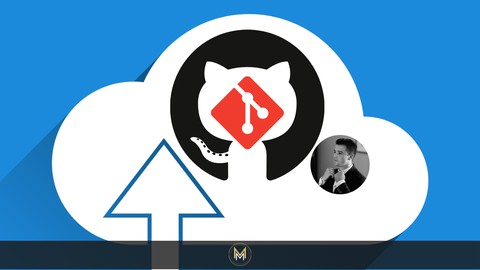
Git and GitHub for Beginners – Version Control & Management
Git and GitHub for Beginners – Version Control & Management, available at $74.99, has an average rating of 4.55, with 84 lectures, based on 10 reviews, and has 50 subscribers.
You will learn about Learn everything you need to work with Git, from repositories, commits, branches, push and pull requests and much more Understand the in & outs of Git and how it works behind the scenes from understanding local & remote as well as local-tracking & remote-tracking branches Become a efficiently projects manager with Git & GitHub by managing your teams pull requests and comparing different branches of the project Create and publish your own website on GitHub using GitHub Pages Learn to collaborate with projects via Git & GitHub and contribute to open source repositories This course is ideal for individuals who are Beginner or Web developers or Front End Web Developers or Back End Web developers or Full Stack Developers or Project managers It is particularly useful for Beginner or Web developers or Front End Web Developers or Back End Web developers or Full Stack Developers or Project managers.
Enroll now: Git and GitHub for Beginners – Version Control & Management
Summary
Title: Git and GitHub for Beginners – Version Control & Management
Price: $74.99
Average Rating: 4.55
Number of Lectures: 84
Number of Published Lectures: 83
Number of Curriculum Items: 85
Number of Published Curriculum Objects: 84
Original Price: €69.99
Quality Status: approved
Status: Live
What You Will Learn
- Learn everything you need to work with Git, from repositories, commits, branches, push and pull requests and much more
- Understand the in & outs of Git and how it works behind the scenes from understanding local & remote as well as local-tracking & remote-tracking branches
- Become a efficiently projects manager with Git & GitHub by managing your teams pull requests and comparing different branches of the project
- Create and publish your own website on GitHub using GitHub Pages
- Learn to collaborate with projects via Git & GitHub and contribute to open source repositories
Who Should Attend
- Beginner or Web developers
- Front End Web Developers
- Back End Web developers
- Full Stack Developers
- Project managers
Target Audiences
- Beginner or Web developers
- Front End Web Developers
- Back End Web developers
- Full Stack Developers
- Project managers
What is Version Control?
What is Git?
What is GitHub?
Why Should I learn Git and GitHub ?
All this questions are answered here.
Git and GitHub are essential tools that sooner or later each developer needs to learn.
Hi! My name is Norbert and this is my Git and GitHub for complete beginners course.
Eider you are a freelancer or work at a company the probabilities that you will collaborate with others on a project or multiple projects, are prate hi to most certain. Even if you go full lonely wolf you still need some sort of backup, redundancy, version control and remote repository system.
No matter if you’re just getting started with (web) development, or applying for a developer job or if you just need to refresh your knowledge on Git and GitHub, version control and version management are a core skills and a must know for all developers.
The best toll on the market for version control are Git and GitHub, and they are the most popular version management and repository systems. Also the synergy between Git and GitHub makes them a reliable source for remote work. Also combining them with Microsoft Visual Studio Code will increase your development speed.
This course will guide you from a complete beginner with 0 knowledge of Git and GitHub, to be confident and efficient when working with version control and version management systems.
Prier Knowledge?
Absolutely No prier knowledge is required.
What will you learn ?
-
Essential Mac and Windows terminal commends for
-
Accessing files and directories using the Mac Terminal and Windows cmd
-
Creating and Deleting files and directories using the Mac Terminal and Windows cmd
-
Flagging files and directories using the Mac Terminal and Windows cmd
-
Copying, Renaming and Moving files and directories using the Mac Terminal and Windows cmd
-
-
What is Git and version management
-
How Git works and how to install git on Mac and PC
-
How to create a repository in git
-
How to add, commnit and log your commits to a git repository
-
What are branches, how to create, merge and delete branches
-
How .gitignore works
-
-
What is GitHub remote control
-
How git and GitHub work together
-
How to go from a local repository to a remote repository
-
How to create a GitHub Account, and your first Remote repository
-
How to connect and pushing to your repository, also log your pushing history and branches
-
What are Remote and local tracking branches
-
How to create a local tracking branch
-
From Local-Remote Workflow important commands
-
From Remote to local repositories with “Cloning“
-
What is the upstream, branches with and without
-
How to delete branches and public commits
-
-
How GitHub collaboration works
-
What the difference between Public and Privat Repositories is
-
How to change a Public to a private repository and back
-
How to Fork a repository
-
How to create a pull request, accepting and merging the pull request to the main branch
-
How to add and remove collaborators from a repository
-
How to contribute to open source projects and repositories
-
-
How you can host your websites on GitHub
-
What is GitHub Pages and how it works
-
How to create a website using GitHub pages
-
What is a static site generator and how to create a static website and host it on GitHub
-
How to add more content to a website by adding multiple pages
-
How to publish and unpublish your website using GitHub Pages.
-
-
Real World Projects
-
Create and contribute to a modern-landing-page repository
-
Contribute to the BarniCoin-Blockchain (NOT A REAL BLOCKCHAIN)
-
Course Curriculum
Chapter 1: Introduction
Lecture 1: Introduction
Lecture 2: Course Overview
Lecture 3: Course Terminologies
Lecture 4: What is Git
Lecture 5: What is GitHub
Lecture 6: Why learn Git and GitHub
Chapter 2: Mac and Windows terminal commends
Lecture 1: Section overview
Lecture 2: GUI vs Text Commands
Lecture 3: Mac Terminology
Lecture 4: Mac Terminal basics
Lecture 5: Mac Terminal Accessing Folders
Lecture 6: Mac Terminal Creating and Deleting Files/Directories
Lecture 7: Mac Terminal Flagging & Removing Files/Folders
Lecture 8: Mac Terminal Copying, Moving, Renaming Files/Directories
Lecture 9: Mac Terminal Recap and cheatsheet
Lecture 10: Windows Terminology
Lecture 11: Windows ( cmd ) basic navigation
Lecture 12: Win cmd Absolute and Relative Navigation
Lecture 13: Windows cmd Creating and Deleting Files/Folders
Lecture 14: Windows cmd copy and Move Files/Folders
Lecture 15: Win commands recap and summary
Lecture 16: Useful links & Resources for Mac And Windows
Chapter 3: Git and version management
Lecture 1: Section overview
Lecture 2: How Git works
Lecture 3: Working locally vs repository
Lecture 4: Branching
Lecture 5: Installing Git on Windows
Lecture 6: Installing Git on Mac
Lecture 7: Install VS Code
Lecture 8: What is a Repository, how initializing and committing works
Lecture 9: Adding to the Repository
Lecture 10: Commiting to a Repository
Lecture 11: Logging the Repository
Lecture 12: Creating and Working with Branches
Lecture 13: Merging different branches
Lecture 14: What is HEAD in Git?
Lecture 15: What is detached HEAD in Git
Lecture 16: Switching Branches in Git
Lecture 17: Deleting date form Working directory
Lecture 18: How to Undo Unstaged Changes
Lecture 19: How to Undo staged Changes
Lecture 20: How to delete commits in Git using git reset
Lecture 21: How to delete a branch in Git
Lecture 22: How to ignore files and directories to be tract in Git
Chapter 4: GitHub and remote controlled
Lecture 1: Section overview
Lecture 2: How git & GitHub work together
Lecture 3: From a local repository to a remote repository
Lecture 4: Create a GitHub Account and UI Overview
Lecture 5: Connecting and pushing to your repository
Lecture 6: Pushing history and branches
Lecture 7: Remote and local tracking of branches
Lecture 8: Create a local tracking branch
Lecture 9: From Local-Remote Workflow important commands
Lecture 10: From Remote to local repositories with "Cloning"
Lecture 11: What is the upstream, branches with and without it.
Lecture 12: Deleting branches and public commits
Lecture 13: Recap
Chapter 5: GitHub collaboration
Lecture 1: Section overview
Lecture 2: Public vs privet repositories
Lecture 3: Changing Public to Private Repo
Lecture 4: Forking a existing repository, fork workflow
Lecture 5: Creating a pull request for a repository
Lecture 6: Merging pull request branches
Lecture 7: Adding Collaborators to repositories
Lecture 8: Removing Collaborators from repositories
Lecture 9: Contributing to open source
Chapter 6: Hosting websites on GitHub
Lecture 1: Section overview
Lecture 2: What is GitHub Pages and how it works
Lecture 3: Create your own website on GitHub using GitHub pages
Lecture 4: Static site generator on GitHub
Lecture 5: Adding more content to your GitHub Pages
Lecture 6: Optional! Contribute to the website.
Lecture 7: Unpublishing a GitHub Pages website
Chapter 7: Real Collaborative Project
Lecture 1: Project overview
Lecture 2: Project objective
Lecture 3: Create a project repository
Lecture 4: Contribute to the project
Lecture 5: Accepting pull request and merging the contributor branch
Lecture 6: Publish your website on github
Chapter 8: Project add to the BarniCoin Blockchain
Lecture 1: Project overview
Lecture 2: Fork repo and create your own block
Lecture 3: Repository for the BarniCoin Blockchain
Chapter 9: Extra content
Lecture 1: More Course
Instructors
-
Norbert B. Menyhart
"Knowledge is Power" Acquire Knowledge by Learning!
Rating Distribution
- 1 stars: 0 votes
- 2 stars: 0 votes
- 3 stars: 1 votes
- 4 stars: 3 votes
- 5 stars: 6 votes
Frequently Asked Questions
How long do I have access to the course materials?
You can view and review the lecture materials indefinitely, like an on-demand channel.
Can I take my courses with me wherever I go?
Definitely! If you have an internet connection, courses on Udemy are available on any device at any time. If you don’t have an internet connection, some instructors also let their students download course lectures. That’s up to the instructor though, so make sure you get on their good side!
You may also like
- Best Video Editing Courses to Learn in March 2025
- Best Music Production Courses to Learn in March 2025
- Best Animation Courses to Learn in March 2025
- Best Digital Illustration Courses to Learn in March 2025
- Best Renewable Energy Courses to Learn in March 2025
- Best Sustainable Living Courses to Learn in March 2025
- Best Ethical AI Courses to Learn in March 2025
- Best Cybersecurity Fundamentals Courses to Learn in March 2025
- Best Smart Home Technology Courses to Learn in March 2025
- Best Holistic Health Courses to Learn in March 2025
- Best Nutrition And Diet Planning Courses to Learn in March 2025
- Best Yoga Instruction Courses to Learn in March 2025
- Best Stress Management Courses to Learn in March 2025
- Best Mindfulness Meditation Courses to Learn in March 2025
- Best Life Coaching Courses to Learn in March 2025
- Best Career Development Courses to Learn in March 2025
- Best Relationship Building Courses to Learn in March 2025
- Best Parenting Skills Courses to Learn in March 2025
- Best Home Improvement Courses to Learn in March 2025
- Best Gardening Courses to Learn in March 2025






















